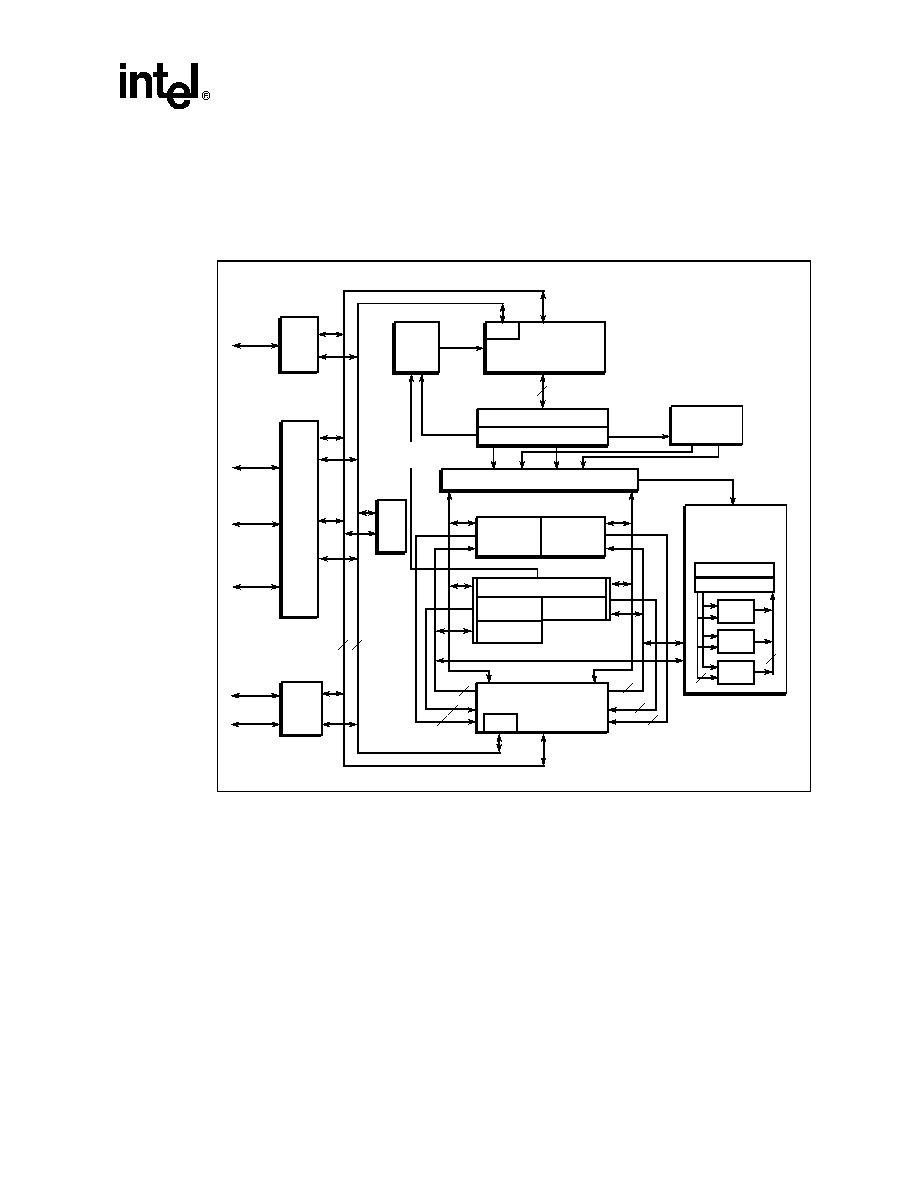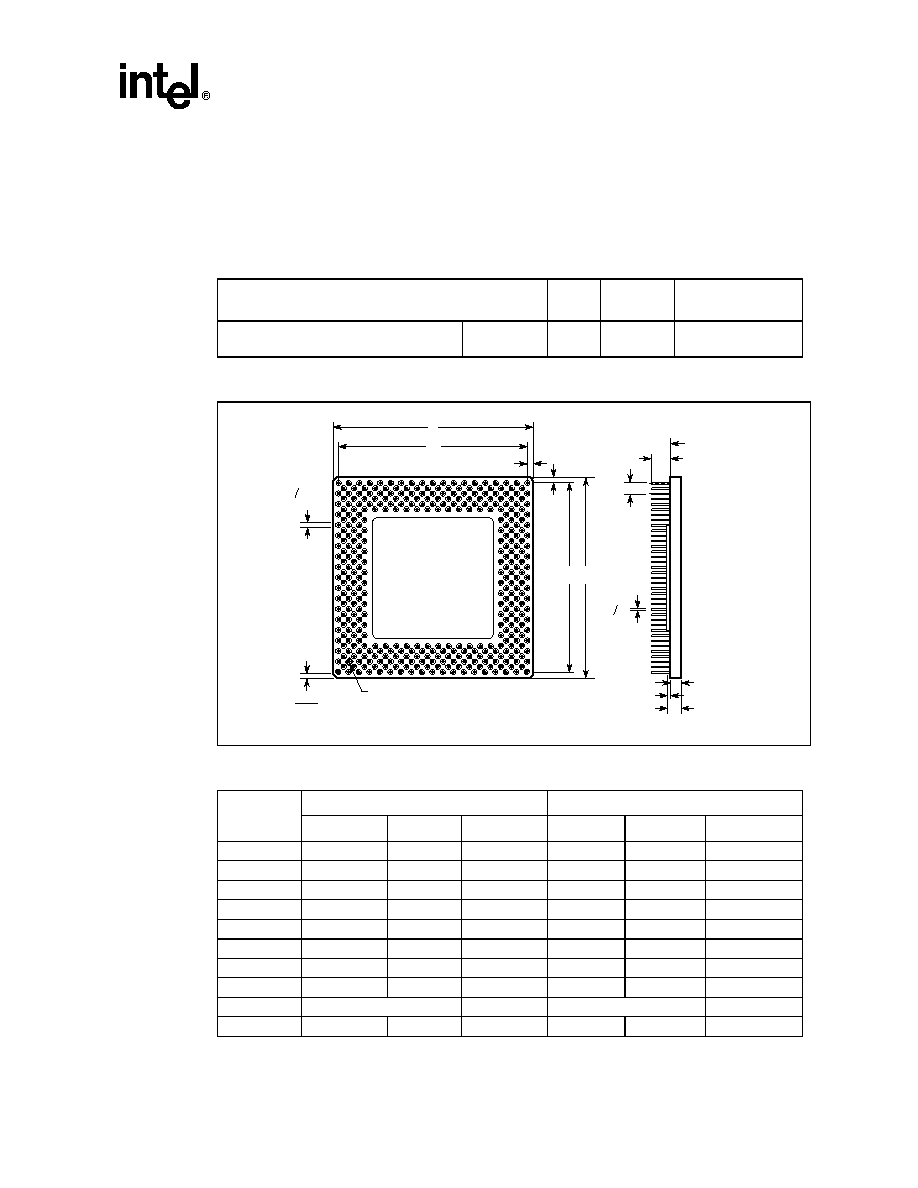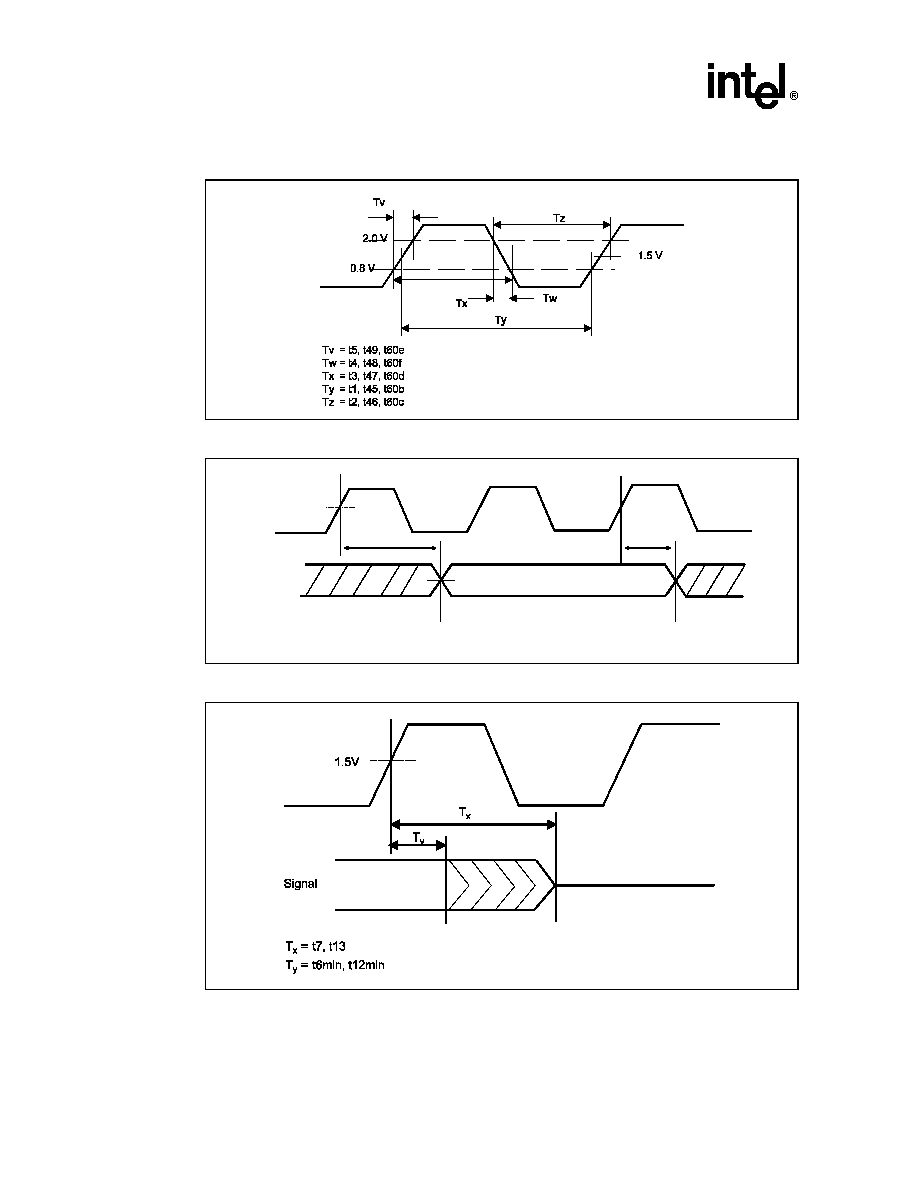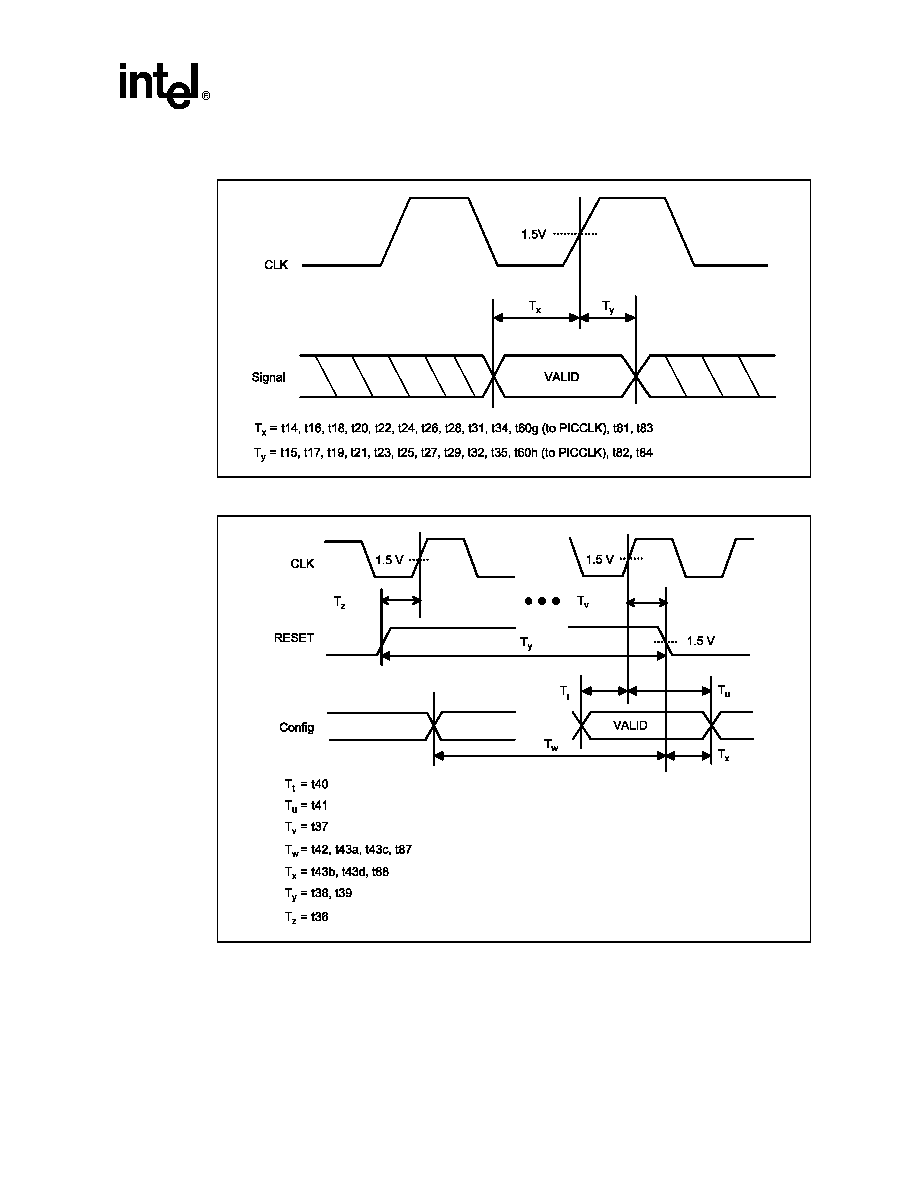 | –≠–ª–µ–∫—Ç—Ä–æ–Ω–Ω—ã–π –∫–æ–º–ø–æ–Ω–µ–Ω—Ç: INTELDX2 | –°–∫–∞—á–∞—Ç—å:  PDF PDF  ZIP ZIP |

Embedded Pentium
Æ
Processor
100 MHz, 133 MHz, 166 MHz
Datasheet
Product Features
The embedded Pentium
Æ
processor provides high performance for embedded applications. The
Pentium processor is compatible with the entire installed base of applications for DOS*,
Windows*, OS/2*, and UNIX*.
The Pentium processor superscalar architecture can execute two instructions per clock cycle.
Branch prediction and separate code and data caches also increase performance. The pipelined
floating-point unit delivers a high level of performance. Separate code and data caches reduce
cache conflicts while remaining software transparent. The Pentium processor has 3.3 million
transistors and is built on Intel's advanced 3.3 V BiCMOS silicon technology. The Pentium
processor has on-chip dual processing support, a local multiprocessor interrupt controller, and
SL power management features.
s
Compatible with Large Software Base
-- MS-DOS*, Windows*, OS/2*, UNIX*
s
32-Bit Processor with 64-Bit Data Bus
s
Superscalar Architecture
-- Two Pipelined Integer Units are Capable
of Two Instructions/Clock
-- Pipelined Floating-Point Unit
s
Separate Code and Data Caches
-- 8-Kbyte Code, 8-Kbyte Write-Back Data
-- MESI Cache Protocol
s
Advanced Design Features
-- Branch Prediction
-- Virtual Mode Extensions
s
3.3 V BiCMOS Silicon Technology
s
4-Mbyte Pages for Increased TLB Hit Rate
s
IEEE 1149.1 Boundary Scan
s
Dual Processing Configuration
s
Functional Redundancy Checking Support
s
Internal Error Detection Features
s
Multiprocessor Support
-- Multiprocessor Instructions
-- Support for Second-level Cache
s
On-Chip Local APIC Controller
-- Multiprocessor Interrupt Management
-- 8259 Compatible
s
Power Management Features
-- System Management Mode
-- Clock Control
s
Fractional Bus Operation
-- 166-MHz Core/66-MHz Bus
-- 133-MHz Core/66-MHz Bus
-- 100-MHz Core/66-MHz Bus
s
iCOMP
Æ
Index 2.0 Rating
-- 127 at 166 MHz
-- 111 at 133 MHz
-- 90 at 100 MHz
Contact Intel Corporation for more information about iCOMP
Æ
Index 2.0 ratings.
Order Number: 273202-001
November 1998

Datasheet
Information in this document is provided in connection with Intel products. No license, express or implied, by estoppel or otherwise, to any intellectual
property rights is granted by this document. Except as provided in Intel's Terms and Conditions of Sale for such products, Intel assumes no liability
whatsoever, and Intel disclaims any express or implied warranty, relating to sale and/or use of Intel products including liability or warranties relating to
fitness for a particular purpose, merchantability, or infringement of any patent, copyright or other intellectual property right. Intel products are not
intended for use in medical, life saving, or life sustaining applications.
Intel may make changes to specifications and product descriptions at any time, without notice.
Designers must not rely on the absence or characteristics of any features or instructions marked "reserved" or "undefined." Intel reserves these for
future definition and shall have no responsibility whatsoever for conflicts or incompatibilities arising from future changes to them.
The Pentium
Æ
processor may contain design defects or errors known as errata which may cause the product to deviate from published specifications.
Current characterized errata are available on request.
MPEG is an international standard for video compression/decompression promoted by ISO. Implementations of MPEG CODECs, or MPEG enabled
platforms may require licenses from various entities, including Intel Corporation.
Contact your local Intel sales office or your distributor to obtain the latest specifications and before placing your product order.
Copies of documents which have an ordering number and are referenced in this document, or other Intel literature may be obtained by calling 1-800-
548-4725 or by visiting Intel's website at http://www.intel.com.
Copyright © Intel Corporation, 1993, 1996, 1997, 1998
*Third-party brands and names are the property of their respective owners.

Datasheet
3
Embedded Pentium
Æ
Processor
Contents
1.0
Architecture Overview
............................................................................................. 7
1.1
Pentium
Æ
Processor Family Architecture .............................................................. 8
1.2
Pentium
Æ
Processors with Voltage Reduction Technology................................. 10
2.0
Packaging Information
........................................................................................... 11
2.1
Pentium
Æ
Processor Pinout................................................................................. 11
2.1.1
Pin Cross Reference .............................................................................. 13
2.1.2
Design Notes.......................................................................................... 15
2.1.3
Pin Quick Reference .............................................................................. 15
2.1.4
Pin Reference Tables............................................................................. 21
2.1.5
Pin Grouping According to Function....................................................... 24
2.2
Mechanical Specifications ................................................................................... 25
2.3
Thermal Specifications ........................................................................................ 26
2.3.1
Measuring Thermal Values .................................................................... 26
2.3.2
Thermal Equations And Data ................................................................. 27
3.0
Electrical Specifications
........................................................................................ 29
3.1
3.3 V Power Supply............................................................................................. 29
3.2
3.3 V Inputs and Outputs..................................................................................... 29
3.3
Absolute Maximum Ratings................................................................................. 29
3.4
DC Specifications ................................................................................................ 30
3.5
AC Specifications ................................................................................................ 31
3.5.1
Private Bus ............................................................................................. 31
3.5.2
Power and Ground ................................................................................. 31
3.5.3
Decoupling Recommendations .............................................................. 32
3.5.4
Connection Specifications ...................................................................... 32
3.5.5
AC Timing Tables................................................................................... 32

Embedded Pentium
Æ
Processor
4
Datasheet
Figures
1
Embedded Pentium
Æ
Processor Block Diagram ................................................... 9
2
Pentium
Æ
Processor SPGA Package Pinout (Top Side View) ............................ 11
3
Pentium
Æ
Processor SPGA Package Pinout (Pin Side View) ............................. 12
4
SPGA Package Dimensions ............................................................................... 25
5
Technique for Measuring Case Temperature (T
C
).............................................. 27
6
Clock Waveform .................................................................................................. 38
7
Valid Delay Timings ............................................................................................ 38
8
Float Delay Timings ............................................................................................ 38
9
Setup and Hold Timings...................................................................................... 39
10
Reset and Configuration Timings........................................................................ 39
11
Test Timings........................................................................................................ 40
12
Test Reset Timings ............................................................................................. 40
13
50% V
CC
Measurement of Flight Time................................................................ 41
Tables
1
Pin Cross-Reference by Pin Name -- Address and Data Pins ........................... 13
2
Pin Cross-Reference by Pin Name -- Control Pins ............................................ 14
3
Pin Cross-Reference by Pin Name -- Power, Ground and No Connect Pins .... 15
4
Pin Quick Reference ......................................................................................... 16
5
Bus Frequency Selections .................................................................................. 21
6
Output Pins ......................................................................................................... 21
7
Input Pins ............................................................................................................ 22
8
Input/Output Pins ................................................................................................ 23
9
Inter-processor Input/Output Pins ....................................................................... 23
10
Pin Functional Grouping...................................................................................... 24
11
Package Information Summary for Pentium
Æ
Processor .................................... 25
12
SPGA Package Dimensions Key ........................................................................ 25
13
Power Dissipation Requirements for Thermal Solution Design .......................... 26
14
Thermal Resistances for Embedded Pentium
Æ
Processors................................ 28
15
Absolute Maximum Ratings ................................................................................ 30
16
3.3 V DC Specifications ...................................................................................... 30
17
3.3 V (5 V-Safe) DC Specifications ..................................................................... 30
18
Input and Output Characteristics......................................................................... 31
19
AC Specifications ................................................................................................ 33
20
Dual Processor Mode AC Specifications ............................................................ 36
21
Notes for Tables 19 and 20 ................................................................................. 37

Datasheet
5
Embedded Pentium
Æ
Processor
Revision History
Date
Revision
Description
11/12/98
001
This is the first publication of this document.


Embedded Pentium
Æ
Processor
Datasheet
7
1.0
Architecture Overview
The Intel
Æ
embedded Pentium
Æ
processor is binary compatible with the 8086/88, 80286,
Intel386TM DX, Intel386 SX, Intel486TM DX, Intel486 SX, IntelDX2TM, IntelDX4TM and
60/66 MHz Pentium processors.
The embedded Pentium processor family consists of the following products:
∑
Embedded Pentium processors (described in this document).
-- Pentium processor at 166 MHz, iCOMP Index 2.0 rating = 127
-- Pentium processor at 133 MHz, iCOMP Index 2.0 rating = 111
-- Pentium processor at 100 MHz, iCOMP Index 2.0 rating = 90
∑
Pentium processor with Voltage Reduction Technology (described in a separate datasheet,
order number 273203).
-- Pentium processor with Voltage Reduction Technology at 133 MHz, iCOMP Index 2.0
rating = 111
Pentium processor features include:
∑
Superscalar architecture
∑
Dynamic branch prediction
∑
Pipelined floating-point unit
∑
Improved instruction execution time
∑
Separate 8-Kbyte code and 8-Kbyte data caches
∑
Writeback MESI protocol in the data cache
∑
64-Bit data bus
∑
Bus cycle pipelining
∑
Address parity
∑
Internal parity checking
∑
Functional redundancy checking
∑
Execution tracing
∑
Performance monitoring
∑
IEEE 1149.1 boundary scan
∑
System Management Mode
∑
Virtual Mode extensions
∑
Fractional bus operation allowing higher core frequency operation
∑
Dual processing support
∑
SL power management features
∑
On-chip local APIC device

Embedded Pentium
Æ
Processor
8
Datasheet
1.1
Pentium
Æ
Processor Family Architecture
The application instruction set of the Pentium processor family includes the complete Intel486
processor family instruction set with extensions to accommodate some of the additional
functionality of the Pentium processor. All application software written for the Intel386 and
Intel486 family microprocessors runs on Pentium processors without modification. The on-chip
memory management unit is completely compatible with the Intel386 family and Intel486 family
of processors.
Pentium processors implement several enhancements to increase performance. The two instruction
pipelines and the floating-point unit are capable of independent operation. Each pipeline issues
frequently used instructions in a single clock. Together, the dual pipes can issue two integer
instructions in one clock, or one floating-point instruction (under certain circumstances, two
floating-point instructions) in one clock.
Branch prediction is implemented in Pentium processors. To support this, the processor has two
prefetch buffers: one prefetches code in a linear fashion and the other prefetches code according to
the BTB so the needed code is almost always prefetched before it is needed for execution.
The floating-point unit (FPU) is up to ten times faster than the FPU used on the Intel486 processor
for common operations including add, multiply, and load.
Pentium processors include separate code and data caches integrated on-chip to meet performance
goals. Each cache is 8 Kbytes with a 32-byte line size, and is two-way set associative. Each cache
has a dedicated Translation Lookaside Buffer (TLB) to translate linear addresses to physical
addresses. The data cache is configurable to be write back or write through on a line-by-line basis
and follows the MESI protocol. The data cache tags are triple-ported to support two data transfers
and an inquire cycle in the same clock. The code cache is an inherently write-protected cache. The
code cache tags are also triple-ported to support snooping and split-line accesses. Individual pages
can be configured as cacheable or non-cacheable by software or hardware. The caches can be
enabled or disabled by software or hardware.
Pentium processors have a 64-bit data bus for fast data transfer. Burst read and burst write back
cycles are supported. In addition, bus cycle pipelining allows two bus cycles to occur
simultaneously. The Memory Management Unit contains optional extensions to the architecture
which allow 2-Mbyte and 4-Mbyte page sizes.
Pentium processors have added significant data integrity and error detection capability. Data parity
checking is still supported on a byte-by-byte basis. Address parity checking and internal parity
checking features have been added along with a new exception, the machine check exception.
Pentium processors offer functional redundancy checking to provide maximum error detection of
the processor and the interface to the processor. When functional redundancy checking is used, a
second processor, the "checker" executes in lock-step with the "master" processor. The checker
samples the master's outputs, compares those values with the values it computes internally, and
asserts an error signal when a mismatch occurs.
As more and more functions are integrated on-chip, the complexity of board level testing is
increased. To address this, Pentium processors provide test and debug capability. Pentium
processors implement IEEE Boundary Scan (Standard 1149.1). In addition, Pentium processors
provide four breakpoint pins that correspond to each of the debug registers and externally indicate a
breakpoint match. Execution tracing provides external indications when an instruction has
completed execution in either of the two internal pipelines, or when a branch has been taken.

Embedded Pentium
Æ
Processor
Datasheet
9
System Management Mode (SMM) has been implemented along with some extensions to the SMM
architecture. Enhancements to the virtual 8086 mode have been made to increase performance by
reducing the number of times it is necessary to trap to a virtual 8086 monitor.
Figure 1 is a block diagram of the embedded Pentium processor.
The block diagram shows the two instruction pipelines, the "u" pipe and the "v" pipe. The u-pipe
can execute all integer and floating-point instructions. The v-pipe can execute simple integer
instructions and the FXCH floating-point instructions.
The separate code and data caches are shown in the block diagram. The data cache has two ports,
one for each of the two pipes (the tags are triple-ported to allow simultaneous inquire cycles). The
data cache has a dedicated Translation Lookaside Buffer (TLB) to translate linear addresses to the
physical addresses used by the data cache.
The code cache, branch target buffer and prefetch buffers are responsible for getting raw
instructions into the execution units. Instructions are fetched from the code cache or from the
external bus. Branch addresses are remembered by the branch target buffer. The code cache TLB
translates linear addresses to physical addresses used by the code cache.
Figure 1. Embedded Pentium
Æ
Processor Block Diagram
A6053-01
DP
Logic
Control
ROM
Control Unit
Address
Generate
(U Pipeline)
Address
Generate
(V Pipeline)
Control
Bus
Unit
64-Bit
Data Bus
32-Bit
Address
Bus
Control
APIC
TLB
Data Cache
8 Kbytes
Data
Control
Branch
Target
Buffer
Prefetch
Address
Instruction
Pointer
Prefetch Buffers
Instruction Decode
Code Cache
8 Kbytes
TLB
256
64
32
32
32
32
32
32
80
80
Control
Add
Floating Point
Unit
Register File
64-Bit
Data Bus
32-Bit
Addr. Bus
32
Integer Register File
ALU
(U Pipline)
ALU
(V Pipline)
Barrel Shifter
Branch Verification
and Target Address
Divide
Multiply
Page
Unit

Embedded Pentium
Æ
Processor
10
Datasheet
The decode unit decodes the prefetched instructions so the processor can execute the instruction.
The control ROM contains microcode to control the sequence of operations that must be performed
to implement the Pentium processor architecture. The control ROM unit has direct control over
both pipelines.
Pentium processors contain a pipelined floating-point unit that provides a significant floating-point
performance advantage over previous generations of processors.
Symmetric dual processing in a system is supported with two Pentium processors. The two
processors appear to the system as a single processor. Operating systems with dual processing
support properly schedule computing tasks between the two processors. This scheduling of tasks is
transparent to software applications and the end-user. Logic built into the processors supports a
"glueless" interface for easy system design. Through a private bus, the two Pentium processors
arbitrate for the external bus and maintain cache coherency. Dual processing is supported in a
system only if both processors are operating at identical core and bus frequencies.
In this document, in order to distinguish between two Pentium processors in dual processing mode,
one processor is the "Primary" processor and the other is the "Dual" processor. Note that this is a
different concept than that of "master" and "checker" processors described in the discussion on
functional redundancy on page 8.
The Pentium processor supports clock control. When the clock to the processor is stopped, power
dissipation is virtually eliminated. This makes the Pentium processor a good choice for energy-
efficient designs.
The Pentium processor supports fractional bus operation. This allows the processor core to operate
at high frequencies, while communicating with the external bus at lower frequencies.
The Pentium processor contains an on-chip Advanced Programmable Interrupt Controller (APIC).
This APIC implementation supports multiprocessor interrupt management (with symmetric
interrupt distribution across all processors), multiple I/O subsystem support, 8259A compatibility,
and inter-processor interrupt support.
Pentium processor architectural features are described in more detail in the Embedded Pentium
Æ
Processor Family Developer's Manual (order number 273204).
1.2
Pentium
Æ
Processors with Voltage Reduction Technology
The Embedded Pentium processor with Voltage Reduction Technology is described in the
Embedded Pentium
Æ
Processor with Voltage Reduction Technology datasheet (order number
273203).

Embedded Pentium
Æ
Processor
Datasheet
11
2.0
Packaging Information
2.1
Pentium
Æ
Processor Pinout
Figure 2. Pentium
Æ
Processor SPGA Package Pinout (Top Side View)
A5498-01
37
35
33
36
34
32
30
28
31
29
27 26 25 24 23 22 21 20 19 18 17 16 15 14 13 12 11 10
9
8
7
6
5
4
3
2
1
37
35
BE6#
NC
NC
V
CC
V
CC
CPUTYP
R
V
SS
V
CC
T
S
V
SS
V
CC
V
CC
NC
NC
V
CC
V
SS
STPCLK#
V
U
W
FRCMC# BF0
V
CC
V
SS
BF1
X
V
SS
PEN#
Z
Y
IGNNE# INIT
V
CC
NA#
BRDYC#
V
CC
WB/WT# PHIT#
V
CC
BRDY#
V
SS
BOFF#
V
SS
PRDY PHITM#
V
CC
R/S#
NMI
V
CC
HOLD
V
SS
V
SS
SMI#
AB
AA
AC
AD
AE
APCHK# PBREQ# V
CC
D/P#
A23
V
CC
PBGNT#
V
SS
V
SS
INTR
PCD SMIACT# V
CC
A24
A27
V
CC
PCHK#
V
SS
V
SS
A21
AF
AG
AH
AJ
ADS#
HLDA
BREQ
A25
A31
V
SS
LOCK#
V
SS
A22
A26
BE2#
HITM#
BE0# BUSCHK#
BE4#
PWT
INC
A11
NC
SCYC
A3
A7
V
SS
A12
A14
A16
A18
A20
BE7#
BE3#
HIT#
BE1# A20M#
BE5#
D/C#
AP
A5
RESET
CLK
A28
A29
A9
A13
A15
A17
A19
V
CC
33
AL
AK
AL
AM
AN
AN
View of Component
as Mounted on Board
(Pins Down)
V
CC
INC
V
CC
FLUSH#
V
CC
INC
INC
36
34
32
30
28
31
29
27 26 25 24 23 22 21 20 19 18 17 16 15 14 13 12 11 10
9
8
7
6
5
4
3
2
1
A10
V
CC
V
CC
NC
A6
V
SS
V
CC
V
CC
V
CC
V
CC
V
CC
V
SS
AM
V
SS
W/R#
V
SS
V
SS
V
SS
EADS# ADSC#
A8
V
SS
V
SS
A30
A4
V
SS
V
SS
V
SS
V
SS
V
SS
D
D4
D5
F
E
D1
D3
V
CC
D2
PICD0
V
SS
PICCLK
H
G
J
PICD1
V
CC
V
CC
V
SS
D0
K
V
SS
TCK
M
L
TDI
TDO
V
CC
V
SS
TMS
P
N
Q
D6
D7
V
CC
TRST#
V
SS
NC
DP0
D8
R
T
S
V
U
W
X
Z
Y
AB
AA
AC
AD
AE
AF
AG
AH
AJ
AK
D
F
E
H
G
J
K
M
L
P
N
Q
C
B
A
DP7
D63
V
CC
FERR# PM0BP0
V
CC
D62
V
SS
IERR#
V
SS
BP3
BP2
V
CC
PM1BP1
V
SS
INV
CACHE#
V
CC
MI/O#
V
SS
KEN# EWBE#
V
CC
AHOLD
V
SS
D49
D52
D54
D53
D55
V
CC
D48
D50
D51
DP6
D58
D57
V
CC
D56
V
SS
D60
D61
V
CC
D59
V
SS
DP5
D42
D46
D30
D33
D40
D44
DP3
DP1
D26
D28
D12
D19
D23
D37
D39
D35
C
B
A
D10
D14
D47
INC
D29
D32
DP4
D45
D31
D21
D25
D27
D17
D24
DP2
D36
D38
D34
D9
D11
D13
D43
INC
V
SS
V
SS
V
SS
V
SS
V
SS
D20
V
SS
V
SS
D16
V
SS
V
SS
V
SS
V
SS
V
SS
D15
D18
D41
INC
V
CC
V
CC
V
CC
V
CC
V
CC
V
CC
V
CC
V
CC
V
CC
V
CC
V
CC
V
CC
D22
NC

Embedded Pentium
Æ
Processor
12
Datasheet
Figure 3. Pentium
Æ
Processor SPGA Package Pinout (Pin Side View)
A5499-01
37
35
33
36
34
32
30
28
31
29
27
26
25
24
23
22
21
20
19
18
17
16
15
14
13
12
11
10
9
8
7
6
5
4
3
2
1
37
35
BE6#
NC
NC
V
CC
V
CC
CPUTYP
R
V
SS
V
CC
T
S
V
SS
V
CC
V
CC
NC
NC
V
CC
V
SS
STPCLK#
V
U
W
FRCMC#
BF0
V
CC
V
SS
BF1
X
V
SS
PEN#
Z
Y
IGNNE#
INIT
V
CC
NA#
BRDYC#
V
CC
WB/WT#
PHIT#
V
CC
BRDY#
V
SS
BOFF#
V
SS
PRDY
PHITM#
V
CC
R/S#
NMI
V
CC
HOLD
V
SS
V
SS
SMI#
AB
AA
AC
AD
AE
APCHK#
PBREQ#
V
CC
D/P#
A23
V
CC
PBGNT#
V
SS
V
SS
INTR
PCD
SMIACT#
V
CC
A24
A27
V
CC
PCHK#
V
SS
V
SS
A21
AF
AG
AH
AJ
ADS#
HLDA
BREQ
A25
A31
V
SS
LOCK#
V
SS
A22
A26
BE2#
HITM#
BE0#
BUSCHK#
BE4#
PWT
INC
A11
NC
SCYC
A3
A7
V
SS
A12
A14
A16
A18
A20
BE7#
BE3#
HIT#
BE1#
A20M#
BE5#
D/C#
AP
A5
RESET
CLK
A28
A29
A9
A13
A15
A17
A19
V
CC
33
AL
AK
AL
AM
AN
AN
Pin Side View
V
CC
INC
V
CC
FLUSH#
V
CC
INC
INC
36
34
32
30
28
31
29
27
26
25
24
23
22
21
20
19
18
17
16
15
14
13
12
11
10
9
8
7
6
5
4
3
2
1
A10
V
CC
V
CC
NC
A6
V
SS
V
CC
V
CC
V
CC
V
CC
V
CC
V
SS
AM
V
SS
W/R#
V
SS
V
SS
V
SS
EADS#
ADSC#
A8
V
SS
V
SS
A30
A4
V
SS
V
SS
V
SS
V
SS
V
SS
D
D4
D5
F
E
D1
D3
V
CC
D2
PICD0
V
CC
V
SS
PICCLK
H
G
J
PICD1
V
CC
V
CC
V
SS
D0
K
V
SS
TCK
M
L
TDI
TDO
V
CC
V
SS
TMS
P
N
Q
D6
D7
V
CC
TRST#
V
SS
NC
DP0
D8
R
T
S
V
U
W
X
Z
Y
AB
AA
AC
AD
AE
AF
AG
AH
AJ
AK
D
F
E
H
G
J
K
M
L
P
N
Q
C
B
A
DP7
D63
V
CC
FERR#
PM0BP0
V
CC
D62
V
SS
IERR#
V
SS
BP3
BP2
V
CC
PM1BP1
V
SS
INV
CACHE#
V
CC
MI/O#
V
SS
KEN#
EWBE#
V
CC
AHOLD
V
SS
D49
D52
D54
D53
D55
V
CC
D48
D50
D51
DP6
D58
D57
V
CC
D56
V
SS
D60
D61
V
CC
D59
V
SS
DP5
D42
D46
D30
D33
D40
D44
DP3
DP1
D26
D28
D12
D19
D23
D37
D39
D35
C
B
A
D10
D14
D47
INC
D29
D32
DP4
D45
D31
D21
D25
D27
D17
D24
DP2
D36
D38
D34
D9
D11
D13
D43
INC
V
SS
V
SS
V
SS
V
SS
V
SS
D20
V
SS
V
SS
D16
V
SS
V
SS
V
SS
V
SS
V
SS
D15
D18
D41
INC
V
CC
V
CC
V
CC
V
CC
V
CC
V
CC
V
CC
V
CC
V
CC
V
CC
V
CC
V
CC
D22
NC

Embedded Pentium
Æ
Processor
Datasheet
13
2.1.1
Pin Cross Reference
Table 1. Pin Cross-Reference by Pin Name -- Address and Data Pins
Pin
Location
Pin
Location
Pin
Location
Pin
Location
Pin
Location
Address
A3
AL35
A9
AK30
A15
AK26
A21
AF34
A27
AG33
A4
AM34
A10
AN31
A16
AL25
A22
AH36
A28
AK36
A5
AK32
A11
AL31
A17
AK24
A23
AE33
A29
AK34
A6
AN33
A12
AL29
A18
AL23
A24
AG35
A30
AM36
A7
AL33
A13
AK28
A19
AK22
A25
AJ35
A31
AJ33
A8
AM32
A14
AL27
A20
AL21
A26
AH34
Data
D0
K34
D13
B34
D26
D24
D39
D10
D52
E03
D1
G35
D14
C33
D27
C21
D40
D08
D53
G05
D2
J35
D15
A35
D28
D22
D41
A05
D54
E01
D3
G33
D16
B32
D29
C19
D42
E09
D55
G03
D4
F36
D17
C31
D30
D20
D43
B04
D56
H04
D5
F34
D18
A33
D31
C17
D44
D06
D57
J03
D6
E35
D19
D28
D32
C15
D45
C05
D58
J05
D7
E33
D20
B30
D33
D16
D46
E07
D59
K04
D8
D34
D21
C29
D34
C13
D47
C03
D60
L05
D9
C37
D22
A31
D35
D14
D48
D04
D61
L03
D10
C35
D23
D26
D36
C11
D49
E05
D62
M04
D11
B36
D24
C27
D37
D12
D50
D02
D63
N03
D12
D32
D25
C23
D38
C09
D51
F04

Embedded Pentium
Æ
Processor
14
Datasheet
Table 2. Pin Cross-Reference by Pin Name -- Control Pins
Pin
Location
Pin
Location
Pin
Location
Pin
Location
A20M#
AK08
BRDYC#
Y03
FLUSH#
AN07
PEN#
Z34
ADS#
AJ05
BREQ
AJ01
FRCMC#
Y35
PM0/BP0
Q03
ADSC#
AM02
BUSCHK#
AL07
HIT#
AK06
PM1/BP1
R04
AHOLD
V04
CACHE#
U03
HITM#
AL05
PRDY
AC05
AP
AK02
CPUTYP
Q35
HLDA
AJ03
PWT
AL03
APCHK#
AE05
D/C#
AK04
HOLD
AB04
R/S#
AC35
BE0#
AL09
D/P#
AE35
IERR#
P04
RESET
AK20
BE1#
AK10
DP0
D36
IGNNE#
AA35
SCYC
AL17
BE2#
AL11
DP1
D30
INIT
AA33
SMI#
AB34
BE3#
AK12
DP2
C25
INTR/
LINT0
AD34
SMIACT#
AG03
BE4#
AL13
DP3
D18
INV
U05
TCK
M34
BE5#
AK14
DP4
C07
KEN#
W05
TDI
N35
BE6#
AL15
DP5
F06
LOCK#
AH04
TDO
N33
BE7#
AK16
DP6
F02
M/IO#
T04
TMS
P34
BOFF#
Z04
DP7
N05
NA#
Y05
TRST#
Q33
BP2
S03
EADS#
AM04
NMI/LINT1
AC33
W/R#
AM06
BP3
S05
EWBE#
W03
PCD
AG05
WB/WT#
AA05
BRDY#
X04
FERR#
Q05
PCHK#
AF04
APIC
PICCLK
H34
PICD0/
[DPEN#]
J33
PICD1/
[APICEN]
L35
Clock Control
CLK
AK18
BF0
Y33
BF1
X34
STPCLK#
V34
Dual Processor Private Interface
PBGNT#
AD04
PBREQ#
AE03
PHIT#
AA03
PHITM#
AC03

Embedded Pentium
Æ
Processor
Datasheet
15
2.1.2
Design Notes
For reliable operation, always connect unused inputs to an appropriate signal level. Unused active
low inputs should be connected to V
CC
. Unused active high inputs should be connected to GND.
No Connect (NC) pins must remain unconnected. Connection of NC pins may result in component
failure or incompatibility with processor steppings.
2.1.3
Pin Quick Reference
This section gives a brief functional description of each of the pins. For a detailed description, see
the Pentium
Æ
Processor Family Developer's Manual (order number 273204).
Note:
All input pins must meet their AC/DC specifications to guarantee proper functional behavior.
The # symbol at the end of a signal name indicates that the active, or asserted state occurs when the
signal is at a low voltage. When a # symbol is not present after the signal name, the signal is active,
or asserted at the high voltage level. Square brackets around a signal name indicate that the signal is
defined only at RESET.
The following pins become I/O pins when two Pentium processors are operating in a dual
processing environment:
∑
ADS#, CACHE#, HIT#, HITM#, HLDA#, LOCK#, M/IO#, D/C#, W/R#, SCYC
Table 3. Pin Cross-Reference by Pin Name -- Power, Ground and No Connect Pins
V
CC
A07
A19
E37
L33
S01
W01
AC01
AN09
AN21
A09
A21
G01
L37
S37
W37
AC37
AN11
AN23
A11
A23
G37
N01
T34
Y01
AE01
AN13
AN25
A13
A25
J01
N37
U01
Y37
AE37
AN15
AN27
A15
A27
J37
Q01
U33
AA01
AG01
AN17
AN29
A17
A29
L01
Q37
U37
AA37
AG37
AN19
V
SS
B06
B18
H02
P02
U35
Z36
AF36
AM12
AM24
B08
B20
H36
P36
V02
AB02
AH02
AM14
AM26
B10
B22
K02
R02
V36
AB36
AJ37
AM16
AM28
B12
B24
K36
R36
X02
AD02
AL37
AM18
AM30
B14
B26
M02
T02
X36
AD36
AM08
AM20
AN37
B16
B28
M36
T36
Z02
AF02
AM10
AM22
NC/INC
A03
B02
R34
S35
W35
AL19
AN03
AN35
A37
C01
S33
W33
AL01
AN01
AN05
These pins should be left unconnected. Connection of these pins may result in component failure or
incompatibility with processor steppings.

Embedded Pentium
Æ
Processor
16
Datasheet
Table 4. Pin Quick Reference (Sheet 1 of 5)
Symbol
Type
Name and Function
A20M#
I
When the address bit 20 mask pin is asserted, the processor emulates the address
wraparound at 1 Mbyte that occurs on the 8086 by masking physical address bit 20
(A20) before performing a lookup to the internal caches or driving a memory cycle
on the bus. The effect of A20M# is undefined in protected mode. A20M# must be
asserted only when the processor is in real mode.
A20M# is internally masked by the processor when configured as a Dual processor.
A31≠A3
I/O
As outputs, the address lines of the processor along with the byte enables define
the physical area of memory or I/O accessed. The external system drives the inquire
address to the processor on A31≠A5.
ADS#
O
The address strobe indicates that a new valid bus cycle is currently being driven by
the processor.
ADSC#
O
The additional address strobe signal is functionally identical to ADS#. This signal
can be used to relieve tight board timings by easing the load on the ADS# signal.
AHOLD
I
In response to the assertion of address hold, the processor stops driving the
address lines (A31≠A3), and AP in the next clock. The rest of the bus remains active
so data can be returned or driven for previously issued bus cycles.
AP
I/O
Address parity is driven by the processor with even parity information on all
processor generated cycles in the same clock in which the address is driven. Even
parity must be driven back to the processor during inquire cycles on this pin in the
same clock as EADS# to ensure that the correct parity check status is indicated by
the processor.
APCHK#
O
The address parity check status pin is asserted two clocks after EADS# is sampled
active if the processor has detected a parity error on the address bus during inquire
cycles. APCHK# remains active for one clock each time a parity error is detected
(including during dual processing private snooping).
[APICEN]
PICD1
I
Advanced programmable interrupt controller enable enables or disables the on≠
chip APIC interrupt controller. If sampled high at the falling edge of RESET, the APIC
is enabled. APICEN shares a pin with the PICD1 signal.
BE7#≠BE5#
BE4#≠BE0#
O
I/O
The byte enable pins determine which bytes must be written to external memory, or
which bytes were requested by the CPU for the current cycle. The byte enables are
driven in the same clock as the address lines (A31≠A3).
The lower four byte enable pins (BE3#≠BE0#) are used as APIC ID inputs and are
sampled at RESET.
In dual processing mode, BE4# is used as an input during Flush cycles.
BF1≠BF0
I
Bus frequency determines the bus-to-core frequency ratio. BF1≠BF0 are sampled
at RESET, and cannot be changed until another non-warm (1 ms) assertion of
RESET. Additionally, BF1≠BF0 must not change values while RESET is active. See
Table 5 for bus frequency selections.
BOFF#
I
The backoff input is used to abort all outstanding bus cycles that have not yet
completed. In response to BOFF#, the processor floats all pins normally floated
during bus hold in the next clock. The processor remains in bus hold until BOFF# is
negated, at which time the processor restarts the aborted bus cycle(s) in their
entirety.
BP3≠BP2
PM1/BP1≠
PM0/BP0
O
The breakpoint pins (BP3≠BP0) correspond to the debug registers, DR3≠DR0.
These pins externally indicate a breakpoint match when the debug registers are
programmed to test for breakpoint matches.
BP1 and BP0 are multiplexed with the performance monitoring pins (PM1 and
PM0). The PB1 and PB0 bits in the Debug Mode Control Register determine if the
pins are configured as breakpoint or performance monitoring pins. The pins come
out of RESET configured for performance monitoring.
The pins are classified as Input or Output based on their function in Master Mode. See the
Pentium
Æ
Processor
Family Developer's Manual
(order number 273204) for more information.

Embedded Pentium
Æ
Processor
Datasheet
17
BRDY#
I
The burst ready input indicates that the external system has presented valid data
on the data pins in response to a read or that the external system has accepted the
processor data in response to a write request. This signal is sampled in the T2, T12
and T2P bus states.
BRDYC#
I
The additional burst ready signal has the same functionality as BRDY#. This signal
can be used to relieve tight board timings by easing the load on the Burst Ready
signal.
BREQ
O
The bus request output indicates to the external system that the processor has
internally generated a bus request. This signal is always driven whether or not the
processor is driving its bus.
BUSCHK#
I
The bus check input allows the system to signal an unsuccessful completion of a
bus cycle. When this pin is sampled active, the processor latches the address and
control signals in the machine check registers. When BUSCHK# is asserted and the
MCE bit in CR4 is set, the processor vectors to the machine check exception.
To ensure that BUSCHK# is always recognized, STPCLK# must be deasserted any
time BUSCHK# is asserted by the system, before the system allows another
external bus cycle. When BUSCHK# is asserted by the system for a snoop cycle
while STPCLK# remains asserted, normally (when MCE=1) the processor vectors to
the exception after STPCLK# is deasserted. When another snoop to the same line
occurs during STPCLK# assertion, the processor can lose the BUSCHK# request.
CACHE#
O
For processor-initiated cycles, the cacheability pin indicates internal cacheability of
the cycle (if a read), and indicates a burst write back cycle (if a write). When this pin
is driven inactive during a read cycle, the processor does not cache the returned
data, regardless of the state of the KEN# pin. This pin is also used to determine the
cycle length (number of transfers in the cycle).
CLK
I
The clock input provides the fundamental timing for the processor. Its frequency is
the operating frequency of the processor's external bus, and requires TTL levels. All
external timing parameters except TDI, TDO, TMS, TRST#, and PICD1≠PICD0 are
specified with respect to the rising edge of CLK.
It is recommended that CLK begin toggling within 150 ms after V
CC
reaches its
proper operating level. This recommendation is to ensure long-term reliability of the
device.
CPUTYP
I
CPU type distinguishes the Primary processor from the Dual processor. In a single
processor environment, or when the processor is acting as the Primary processor in
a dual processing system, CPUTYP should be strapped to V
SS
. The Dual processor
should have CPUTYP strapped to V
CC
.
D/C#
O
The data/code output is one of the primary bus cycle definition pins. It is driven valid
in the same clock in which the ADS# signal is asserted. D/C# distinguishes between
data and code or special cycles.
D/P#
O
The dual/primary processor indication. The Primary processor drives this pin low
when it is driving the bus, otherwise it drives this pin high. D/P# is always driven.
D/P# can be sampled for the current cycle with ADS# (like a status pin). This pin is
defined only on the Primary processor. Dual processing is supported in a system
only if both processors are operating at identical core and bus frequencies. Within
these restrictions, two processors of different steppings may operate together in a
system.
D63≠D0
I/O
These are the 64 data lines for the processor. Lines D7≠D0 define the least
significant byte of the data bus; lines D63≠D56 define the most significant byte of the
data bus. When the CPU is driving the data lines, they are driven during the T2, T12,
or T2P clocks for that cycle. During reads, the CPU samples the data bus when
BRDY# is returned.
Table 4. Pin Quick Reference (Sheet 2 of 5)
Symbol
Type
Name and Function
The pins are classified as Input or Output based on their function in Master Mode. See the
Pentium
Æ
Processor
Family Developer's Manual
(order number 273204) for more information.

Embedded Pentium
Æ
Processor
18
Datasheet
DP7≠DP0
I/O
These are the data parity pins for the processor. There is one for each byte of the
data bus. They are driven by the Pentium processor with even parity information on
writes in the same clock as write data. Even parity information must be driven back
to the processor on these pins in the same clock as the data to ensure that the
correct parity check status is indicated by the Pentium processor. DP7 applies to
D63≠D56, DP0 applies to D7≠D0.
[DPEN#]
PICD0
I/O
Dual processing enable is an output of the Dual processor and an input of the
Primary processor. The Dual processor drives DPEN# low to the Primary processor
at RESET to indicate that the Primary processor should enable dual processor
mode. DPEN# may be sampled by the system at the falling edge of RESET to
determine if the dual-processor socket is occupied. DPEN# shares a pin with PICD0.
EADS#
I
The external address strobe signal indicates that a valid external address has
been driven onto the processor address pins to be used for an inquire cycle.
EWBE#
I
The external write buffer empty input, when inactive (high), indicates that a write
cycle is pending in the external system. When the processor generates a write, and
EWBE# is sampled inactive, the processor holds off all subsequent writes to all E- or
M-state lines in the data cache until all write cycles have completed, as indicated by
EWBE# being active.
FERR#
O
The floating-point error pin is driven active when an unmasked floating-point error
occurs. FERR# is similar to the ERROR# pin on the Intel387TM math coprocessor.
FERR# is included for compatibility with systems using DOS-type floating-point error
reporting. FERR# is never driven active by the Dual processor.
FLUSH#
I
When asserted, the cache flush input forces the processor to write back all
modified lines in the data cache and invalidate its internal caches. A Flush
Acknowledge special cycle is generated by the processor to indicate completion of
the write back and invalidation.
When FLUSH# is sampled low when RESET transitions from high to low, three-state
test mode is entered.
If two Pentium processors are operating in dual processing mode and FLUSH# is
asserted, the Dual processor performs a flush first (without a flush acknowledge
cycle), then the Primary processor performs a flush followed by a flush acknowledge
cycle.
When the FLUSH# signal is asserted in dual processing mode, it must be
deasserted at least one clock prior to BRDY# of the FLUSH Acknowledge cycle to
avoid DP arbitration problems.
FRCMC#
I
The functional redundancy checking master/checker mode input is used to
determine whether the processor is configured in master mode or checker mode.
When configured as a master, the processor drives its output pins as required by the
bus protocol. When configured as a checker, the processor three-states all outputs
(except IERR# and TDO) and samples the output pins.
The configuration as a master/checker is set after RESET and may not be changed
other than by a subsequent RESET.
HIT#
O
The inquire cycle hit/miss indication is driven to reflect the outcome of an inquire
cycle. If an inquire cycle hits a valid line in either the processor data or instruction
cache, this pin is asserted two clocks after EADS# is sampled asserted. If the
inquire cycle misses the processor cache, this pin is negated two clocks after
EADS#. This pin changes its value only as a result of an inquire cycle and retains its
value between the cycles.
HITM#
O
The inquire cycle hit/miss to a modified line output is driven to reflect the
outcome of an inquire cycle. It is asserted after an inquire cycle that results in a hit to
a modified line in the data cache. It is used to inhibit another bus master from
accessing the data until the line is completely written back.
Table 4. Pin Quick Reference (Sheet 3 of 5)
Symbol
Type
Name and Function
The pins are classified as Input or Output based on their function in Master Mode. See the
Pentium
Æ
Processor
Family Developer's Manual
(order number 273204) for more information.

Embedded Pentium
Æ
Processor
Datasheet
19
HLDA
O
The bus hold acknowledge pin goes active in response to a hold request driven to
the processor on the HOLD pin. It indicates that the processor has floated most of
the output pins and relinquished the bus to another local bus master. When leaving
bus hold, HLDA is driven inactive and the processor resumes driving the bus. When
the processor has a bus cycle pending, it is driven in the same clock in which HLDA
is deasserted.
HOLD
I
In response to the bus hold request, the processor floats most of its output and
input/output pins and asserts HLDA after completing all outstanding bus cycles. The
processor maintains its bus in this state until HOLD is deasserted. HOLD is not
recognized during LOCK cycles. The processor recognizes HOLD during reset.
IERR#
O
The internal error pin is used to indicate two types of errors, internal parity errors
and functional redundancy errors. When a parity error occurs on a read from an
internal array, the processor asserts the IERR# pin for one clock and then shuts
down. When the processor is configured as a checker and a mismatch occurs
between the value sampled on the pins and the corresponding value computed
internally, the processor asserts IERR# two clocks after the mismatched value is
returned.
LOCK#
O
The bus lock pin indicates that the current bus cycle is locked. The processor does
not allow a bus hold when LOCK# is asserted (but AHOLD and BOFF# are allowed).
LOCK# goes active in the first clock of the first locked bus cycle and goes inactive
after the BRDY# is returned for the last locked bus cycle. LOCK# is guaranteed to be
deasserted for at least one clock between back-to-back locked cycles.
M/IO#
O
The memory/input-output is one of the primary bus cycle definition pins. It is driven
valid in the same clock in which the ADS# signal is asserted. M/IO# distinguishes
between memory and I/O cycles.
NA#
I
An active next address input indicates that the external memory system is ready to
accept a new bus cycle although all data transfers for the current cycle have not yet
completed. The processor issues ADS# for a pending cycle two clocks after NA# is
asserted. The processor supports up to two outstanding bus cycles.
NMI/LINT1
I
The non-maskable interrupt request signal indicates that an external non-
maskable interrupt has been generated.
When the local APIC is enabled, this pin becomes LINT1.
PBGNT#
I/O
When two Pentium processors are configured in dual processing mode, Private bus
grant is the grant line that is used to perform private bus arbitration. PBGNT# should
be left unconnected if only one Pentium processor exists in a system.
PBREQ#
I/O
When two Pentium processors are configured in dual processing mode, Private bus
request is the request line that is used to perform private bus arbitration. PBREQ#
should be left unconnected if only one Pentium processor exists in a system.
PCD
O
The page cacheability disable pin reflects the state of the PCD bit in CR3, the
Page Directory Entry, or the Page Table Entry. The purpose of PCD is to provide an
external cacheability indication on a page-by-page basis.
PCHK#
O
The data parity check output indicates the result of a parity check on a data read. It
is driven with parity status two clocks after BRDY# is returned. PCHK# remains low
one clock for each clock in which a parity error was detected. Parity is checked only
for the bytes on which valid data is returned.
When two Pentium processors are operating in dual processing mode, PCHK# may
be driven two or three clocks after BRDY# is returned.
PEN#
I
The parity enable input (along with CR4.MCE) determines whether a machine
check exception is taken as a result of a data parity error on a read cycle. When this
pin is sampled active in the clock during which a data parity error is detected, the
processor latches the address and control signals of the cycle with the parity error in
the machine check registers. When PEN# is active and the machine check enable
bit in CR4 is set to "1", the processor vectors to the machine check exception before
the beginning of the next instruction.
Table 4. Pin Quick Reference (Sheet 4 of 5)
Symbol
Type
Name and Function
The pins are classified as Input or Output based on their function in Master Mode. See the
Pentium
Æ
Processor
Family Developer's Manual
(order number 273204) for more information.

Embedded Pentium
Æ
Processor
20
Datasheet
PHIT#
I/O
Private inquire cycle hit/miss is a hit indication used to maintain local cache
coherency when two Pentium processors are configured in dual processing mode.
PHIT# should be left unconnected if only one Pentium processor exists in a system.
PHITM#
I/O
Private inquire cycle hit/miss to a modified line is a hit indication used to
maintain local cache coherency when two Pentium processors are configured in
dual processing mode. PHITM# should be left unconnected if only one Pentium
processor exists in a system.
PICCLK
I
The APIC interrupt controller serial data bus clock is driven into the processor
interrupt controller clock input of the processor.
PICD1/[DPEN#]≠
PICD0/[APICEN]
I/O
Processor interrupt controller data lines 0≠1 of the processor comprise the data
portion of the APIC 3-wire bus. They are open-drain outputs that require external
pull-up resistors. These signals share pins with DPEN# and APICEN respectively.
PM1/BP1≠
PM0/BP0
O
These pins function as part of the performance monitoring feature.
The breakpoint 1≠0 pins are multiplexed with the performance monitoring 1≠0
pins. The PB1 and PB0 bits in the Debug Mode Control Register determine whether
the pins are configured as breakpoint or performance monitoring pins. The pins
come out of RESET configured for performance monitoring.
PRDY
O
The probe ready output pin indicates that the processor has stopped normal
execution in response to the R/S# pin going active, or Probe Mode being entered.
SMIACT#
O
An active system management interrupt active output indicates that the processor
is operating in System Management Mode.
STPCLK#
I
Assertion of the stop clock input signifies a request to stop the internal clock of the
processor, which causes the core to consume less power. When the processor
recognizes STPCLK#, the processor stops execution on the next instruction
boundary, unless superseded by a higher priority interrupt, and generates a stop
grant acknowledge cycle. When STPCLK# is asserted, the processor still responds
to interprocessor and external snoop requests.
TCK
I
The testability clock input provides the clocking function for the Pentium processor
boundary scan in accordance with the IEEE Boundary Scan interface (Standard
1149.1). It is used to clock state information and data into and out of the processor
during boundary scan.
TDI
I
The test data input is a serial input for the test logic. TAP instructions and data are
shifted into the processor on the TDI pin on the rising edge of TCK when the TAP
controller is in an appropriate state.
TDO
O
The test data output is a serial output of the test logic. TAP instructions and data
are shifted out of the processor on the TDO pin on TCK's falling edge when the TAP
controller is in an appropriate state.
TMS
I
The value of the test mode select input signal sampled at the rising edge of TCK
controls the sequence of TAP controller state changes.
TRST#
I
When asserted, the test reset input allows the TAP controller to be asynchronously
initialized.
V
CC
I
The Pentium processor has 53 3.3 V power inputs.
V
SS
I
The Pentium processor has 53 ground inputs.
W/R#
O
Write/read is one of the primary bus cycle definition pins. It is driven valid in the
same clock in which the ADS# signal is asserted. W/R# distinguishes between write
and read cycles.
WB/WT#
I
The write back/write through input allows a data cache line to be defined as write
back or write through on a line-by-line basis. As a result, it determines whether a
cache line is initially in the S or E state in the data cache.
Table 4. Pin Quick Reference (Sheet 5 of 5)
Symbol
Type
Name and Function
The pins are classified as Input or Output based on their function in Master Mode. See the
Pentium
Æ
Processor
Family Developer's Manual
(order number 273204) for more information.

Embedded Pentium
Æ
Processor
Datasheet
21
2.1.4
Pin Reference Tables
Table 5. Bus Frequency Selections
Pentium
Æ
Processor Core
Frequency (max)
External Bus
Frequency (max)
Bus/Core Ratio
BF1
BF0
166 MHz
66 MHz
2/5
0
0
133 MHz
66 MHz
1/2
1
0
100 MHz
66 MHz
2/3
1
1
Table 6. Output Pins
Name
Active Level
1
When Floated
ADS#
2
Low
Bus Hold, BOFF#
ADSC#
Low
Bus Hold, BOFF#
APCHK#
Low
BE7#≠BE5#
Low
Bus Hold, BOFF#
BREQ
High
CACHE#
2
Low
Bus Hold, BOFF#
D/P#
3
n/a
FERR#
3
Low
HIT#
2
Low
HITM#
2
Low
HLDA
2
High
IERR#
Low
LOCK#
2
Low
Bus Hold, BOFF#
M/IO#
2
, D/C#
2
, W/R#
2
n/a
Bus Hold, BOFF#
PCHK#
Low
BP3≠BP2, PM1/BP1, PM0/BP0
High
PRDY
High
PWT, PCD
High
Bus Hold, BOFF#
SCYC
2
High
Bus Hold, BOFF#
SMIACT#
Low
TDO
n/a
All states except Shift-DR and Shift-IR
NOTES:
1. All output and input/output pins are floated during three-state test mode and checker mode (except
IERR#).
2. These are I/O signals when two Pentium
processors are operating in dual processing mode.
3. These signals are undefined when the processor is configured as a dual processor.

Embedded Pentium
Æ
Processor
22
Datasheet
Table
7. Input
Pins
Name
Active Level
Synchronous/
Asynchronous
Internal Resistor
Qualified
A20M#
Low
Asynchronous
AHOLD
High
Synchronous
BF1≠BF0
High
Synchronous/RESET
Pullup
BOFF#
Low
Synchronous
BRDY#
Low
Synchronous
Bus State T2, T12, T2P
BRDYC#
Low
Synchronous
Pullup
Bus State T2, T12, T2P
BUSCHK#
Low
Synchronous
Pullup
BRDY#
CLK
n/a
CPUTYP
High
Synchronous/RESET
EADS#
Low
Synchronous
EWBE#
Low
Synchronous
BRDY#
FLUSH#
Low
Asynchronous
FRCMC#
Low
Asynchronous
HOLD
High
Synchronous
IGNNE#
Low
Asynchronous
INIT
High
Asynchronous
INTR
High
Asynchronous
INV
High
Synchronous
EADS#
KEN#
Low
Synchronous
First BRDY#/NA#
NA#
Low
Synchronous
Bus State T2,TD,T2P
NMI
High
Asynchronous
PEN#
Low
Synchronous
BRDY#
PICCLK
High
Asynchronous
Pullup
R/S#
n/a
Asynchronous
Pullup
RESET
High
Asynchronous
SMI#
Low
Asynchronous
Pullup
STPCLK#
Low
Asynchronous
Pullup
TCK
n/a
Pullup
TDI
n/a
Synchronous/TCK
Pullup
TCK
TMS
n/a
Synchronous/TCK
Pullup
TCK
TRST#
Low
Asynchronous
Pullup
WB/WT#
n/a
Synchronous
First BRDY#/NA#
Undefined when the processor is configured as a dual processor.

Embedded Pentium
Æ
Processor
Datasheet
23
Table 8. Input/Output Pins
Name
Active
Level
When Floated
1
Qualified
(when an input)
Internal
Resistor
A31≠A3
n/a
Address Hold, Bus Hold, BOFF#
EADS#
AP
n/a
Address Hold, Bus Hold, BOFF#
EADS#
BE4#≠BE0#
Low
Address Hold, Bus Hold, BOFF#
RESET
Pulldown
2
D63≠D0
n/a
Bus Hold, BOFF#
BRDY#
DP7≠DP0
n/a
Bus Hold, BOFF#
BRDY#
PICD0[DPEN#]
Pullup
PICD1[APICEN]
Pulldown
NOTES:
1. All output and input/output pins are floated during three-state test mode (except TDO) and checker mode
(except IERR# and TDO).
2. BE3#≠BE0# have pulldowns during RESET only.
Table 9. Inter-processor Input/Output Pins
Name
Active Level
Internal Resistor
PHIT#
Low
Pullup
PHITM#
Low
Pullup
PBGNT#
Low
Pullup
PBREQ#
Low
Pullup
For proper interprocessor operation, the system cannot load these signals.

Embedded Pentium
Æ
Processor
24
Datasheet
2.1.5
Pin Grouping According to Function
Table 10. Pin Functional Grouping
Function
Pins
Clock
CLK
Initialization
RESET, INIT, BF1≠BF0
Address Bus
A31≠A3, BE7#≠BE0#
Address Mask
A20M#
Data Bus
D63≠D0
Address Parity
AP, APCHK#
APIC Support
PICCLK, PICD1≠PICD0
Data Parity
DP7≠DP0, PCHK#, PEN#
Internal Parity Error
IERR#
System Error
BUSCHK#
Bus Cycle Definition
M/IO#, D/C#, W/R#, CACHE#, SCYC, LOCK#
Bus Control
ADS#, ADSC#, BRDY#, BRDYC#, NA#
Page Cacheability
PCD, PWT
Cache Control
KEN#, WB/WT#
Cache Snooping/Consistency
AHOLD, EADS#, HIT#, HITM#, INV
Cache Flush
FLUSH#
Write Ordering
EWBE#
Bus Arbitration
BOFF#, BREQ, HOLD, HLDA
Dual Processing Private Bus Control
PBGNT#, PBREQ#, PHIT#, PHITM#
Interrupts
INTR, NMI
Floating-point Error Reporting
FERR#, IGNNE#
System Management Mode
SMI#, SMIACT#
Functional Redundancy Checking
FRCMC# (IERR#)
TAP Port
TCK, TMS, TDI, TDO, TRST#
Breakpoint/Performance Monitoring
PM0/BP0, PM1/BP1, BP3≠BP2
Power Management
STPCLK#
Miscellaneous Dual Processing
CPUTYP, D/P#
Probe Mode
R/S#, PRDY

Embedded Pentium
Æ
Processor
Datasheet
25
2.2
Mechanical Specifications
The embedded Pentium processor is packaged in a 296-pin ceramic staggered pin grid array
(SPGA) package. The pins are arranged in a 37 x 37 matrix and the package dimensions are 1.95"
x 1.95" (Table 11). Figure 4 and Table 12 show the package dimensions.
Table 11. Package Information Summary for Pentium
Æ
Processor
Package Type
Total
Pins
Pin Array
Package Size
Ceramic Staggered Pin Grid Array
SPGA
296
37 x 37
1.95" x 1.95"
4.95 cm x 4.95 cm
Figure 4. SPGA Package Dimensions
Table 12. SPGA Package Dimensions Key
Symbol
Millimeters
Inches
Min Max
Notes Min Max Notes
A 2.62
2.97
0.103
0.117
A
1
0.69
0.84
Metal Lid
0.027
0.033
Metal Lid
A
2
3.31
3.81
Metal Lid
0.130
0.150
Metal Lid
B 0.43
0.51
0.017
0.020
D 49.28
49.78
1.940
1.960
D
1
45.59
45.85
1.795
1.805
e
1
2.29
2.79
0.090
0.110
L 3.05
3.30
0.120
0.130
N
296
Lead Count
296
Lead Count
S
1
1.52
2.54
0.060
0.100
D
D
D
1
A
1
A
2
0B
e
1
S
1
2.29
1.52
45
∞
Chamfer
(index corner)
Ref.
01.65
Ref.
L
Seating Plane
Pin C3
A
S
1
D
1

Embedded Pentium
Æ
Processor
26
Datasheet
2.3
Thermal Specifications
The Pentium processor is specified for proper operation when case temperature, T
CASE
(T
C
), is
within the specified range of 0∞ C to 70∞ C.
The power dissipation specification in Table 13 is provided for designing thermal solutions for
operation at a sustained maximum level. This is the worst-case power the device would dissipate in
a system. This number is used for design of a thermal solution for the device.
2.3.1
Measuring Thermal Values
To verify that the proper T
C
(case temperature) is maintained, it should be measured at the center of
the package top surface (opposite of the pins). The measurement is made in the same way with or
without a heatsink attached. When a heatsink is attached, a hole (0.150" diameter or smaller)
should be drilled through the heatsink to allow a probe to touch the center of the package. See
Figure 5 for an illustration of how to measure T
C
.
To minimize the measurement errors, use the following approach:
∑
Use 36-gauge or finer diameter K, T, or J type thermocouples.
∑
Attach the thermocouple bead or junction to the center of the package top surface using high
thermal conductivity cements.
∑
Attach the thermocouple at a 90-degree angle as shown in Figure 5.
∑
The hole size should be 0.150" or less in diameter.
Table 13. Power Dissipation Requirements for Thermal Solution Design
Parameter
Typical
1
Max
Unit
Notes
Active Power Dissipation
5.4
4.3
3.9
14.5
2
11.2
3
10.1
3
Watts
166 MHz
133 MHz
100 MHz
Stop Grant and Auto Halt Powerdown
Power Dissipation
2.1
1.7
1.55
Watts
166 MHz, Note 4
133 MHz, Note 4
100 MHz, Note 4
Stop Clock Power Dissipation
0.02
<0.3
Watts
Note 5
NOTES:
1. This is the typical power dissipation in a system. This value was the average value measured in a system
using a typical device at nominal V
CC
(3.3 V for 100 and 133 MHz processors and 3.5 V for 166 MHz
processors) running typical applications. This value is highly dependent upon the specific system
configuration.
2. Systems must be designed to thermally dissipate the maximum active power of the device. It is
determined using a worst-case instruction mix with V
CC
=3.5 V, and also takes into account the thermal
time constants of the package.
3. Systems must be designed to thermally dissipate the maximum active power of the device. It is
determined using a worst case instruction mix with V
CC
= 3.3 V and also takes into account the thermal
time constants of the package.
4. Stop Grant/Auto Halt Powerdown power dissipation is determined by asserting the STPCLK# pin or
executing the HALT instruction.
5. Stop Clock power dissipation is determined by asserting the STPCLK# pin and then removing the
external CLK input.

Embedded Pentium
Æ
Processor
Datasheet
27
2.3.2
Thermal Equations And Data
For the Pentium processor, an ambient temperature, T
A
(air temperature around the processor), is
not specified directly. The only restriction is that the case temperature (T
C
) is met. To calculate T
A
values, use the following equations:
T
A
= T
C
≠ (P *
CA
)
CA
=
JA
≠
JC
where:
T
A
and T
C
=
ambient and case temperature (
∞
C)
CA
=
case-to-ambient thermal resistance (
∞
C/W)
JA
=
junction-to-ambient thermal resistance (
∞
C/W)
JC
=
junction-to-case thermal resistance (
∞
C/W)
P =
maximum power consumption in Watts (see Table 13)
Table 14 lists the
CA
values for the Pentium processor with passive heatsinks.
Thermal data collection parameters:
∑
Heatsinks are omnidirectional pin aluminum alloy
∑
Features were based on standard extrusion practices for a given height
∑
Pin size ranged from 50 to 129 mils
∑
Pin spacing ranged from 93 to 175 mils
∑
Base thickness ranged from 79 to 200 mils
∑
Heatsink attach was 0.005" of thermal grease
∑
Using an attach thickness of 0.002" improves performance by approximately 0.3
∞
C/W
Figure 5. Technique for Measuring Case Temperature (T
C
)

Embedded Pentium
Æ
Processor
28
Datasheet
Table 14. Thermal Resistances for Embedded Pentium
Æ
Processors
Heatsink Height in
Inches
JC
(∞C/Watt)
CA
(∞C/Watt) vs. Laminar Airflow (Linear ft/min)
0 100 200 400 600 800
0.25 1.25
9.4
8.3
6.9
4.7
3.9
3.3
0.35 1.25
9.1
7.8
6.3
4.3
3.6
3.1
0.45 1.25
8.7
7.3
5.6
3.9
3.2
2.8
0.55 1.25
8.4
6.8
5.0
3.5
2.9
2.6
0.65 1.25
8.0
6.3
4.6
3.3
2.7
2.4
0.80 1.25
7.3
5.6
4.2
2.9
2.5
2.3
1.00 1.25
6.6
4.9
3.9
2.9
2.4
2.1
1.20 1.25
6.2
4.6
3.6
2.7
2.3
2.1
1.40 1.25
5.7
4.2
3.3
2.5
2.2
2.0
Without Heatsink
1.7
14.5
13.8
12.6
10.5
8.6
7.5

Embedded Pentium
Æ
Processor
Datasheet
29
3.0
Electrical Specifications
This section describes the DC and AC specifications for the embedded Pentium processor.
3.1
3.3 V Power Supply
The processor has all V
CC
3.3-V inputs. The CLK and PICCLK inputs can tolerate a 5-V input
signal. This allows the processor to use 5-V or 3.3-V clock drivers.
3.2
3.3 V Inputs and Outputs
The inputs and outputs of the processor are 3.3 V JEDEC standard levels. Both inputs and outputs
are also TTL-compatible, although the inputs cannot tolerate voltage swings above the 3.3 V V
IN
max. The CLK and PICCLK inputs of the processor are 5 V tolerant. This allows a 5-V clock
driver to drive the processor. All other pins are 3.3 V only.
For processor outputs, if the system support components use TTL-compatible inputs, the
components will interface to the processor without extra logic. This is because the processor drives
according to the 5-V TTL specification (but not beyond 3.3 V).
For processor inputs, the voltage must not exceed the 3.3 V V
IH3
maximum specification. System
support components can consist of 3.3 V devices or open-collector devices. In an open-collector
configuration, the external resistor can be biased with the processor's V
CC
. As the processor's V
CC
changes from 5 V to 3.3 V, so does this signal's maximum drive.
3.3
Absolute Maximum Ratings
Functional operating conditions are given in the AC and DC specification tables. Functional
operation at the maximums is not implied or guaranteed. Extended operation beyond the maximum
ratings may affect device reliability. Furthermore, although the Pentium processor contains
protective circuitry to resist damage from static electric discharge, always take precautions to avoid
high static voltages or electric fields.
Warning:
Stressing the device beyond the "Absolute Maximum Ratings" may cause permanent damage.
These are stress ratings only.

Embedded Pentium
Æ
Processor
30
Datasheet
3.4
DC Specifications
Tables 16≠18 list the DC specifications that apply to the Pentium processor. The Pentium processor
is a 3.3 V part internally. The CLK and PICCLK inputs may be 3.3 V or 5 V inputs. Since the 3.3 V
(5 V-safe) input levels defined in Table 16 are the same as the 5 V TTL levels, the CLK and
PICCLK inputs are compatible with existing 5 V clock drivers.
Table 15. Absolute Maximum Ratings
Parameter
Maximum Rating
Case temperature under bias
-
65
∞
C to 110
∞
C
Storage temperature
-
65
∞
C to 150
∞
C
3 V Supply voltage with respect to V
SS
-
0.5 V to +4.6 V
3 V Only Buffer DC Input Voltage
-
0.5 V to V
CC
+ 0.5; not to exceed V
CC3
max
1
5 V Safe Buffer DC Input Voltage
-
0.5 V to 6.5 V
2,3
NOTES:
1. Applies to all Pentium
Æ
processor inputs except CLK and PICCLK.
2. Applies to CLK and PICCLK.
3. See overshoot/undershoot transient specification.
Table 16. 3.3 V DC Specifications
T
CASE
= 0 to 70∞ C; 3.135 V < V
CC
< 3.6 V for 100 and 133 MHz devices
T
CASE
= 0 to 70∞ C; 3.4 V < V
CC
< 3.6 V for 166 MHz (VRE device)
Symbol
Parameter
Min
Max
Unit
Notes
V
IL3
Input Low Voltage
≠0.3
0.8
V
TTL Level, Note 1
V
IH3
Input High Voltage
2.0
V
CC
+0.3
V
TTL Level, Note 1
V
OL3
Output Low Voltage
0.4
V
TTL Level,
Note 2, Note 1
V
OH3
Output High Voltage
2.4
V
TTL Level,
Note 3, Note 1
I
CC3
Power Supply Current
4250
3400
3250
mA
mA
mA
166 MHz, Note 4
133 MHz, Note 4
100 MHz, Note 4
NOTES:
1. 3.3 V TTL levels apply to all signals except CLK and PICCLK.
2. Parameter measured at 4 mA.
3. Parameter measured at 3 mA.
4. This value should be used for power supply design. It was determined using a worst-case instruction mix
and V
CC
= 3.6 V. Power supply transient response and decoupling capacitors must be sufficient to handle
the instantaneous current changes occurring during transitions from stop clock to full active modes. For
more information, refer to "Decoupling Recommendations" on page 32.
Table 17. 3.3 V (5 V-Safe) DC Specifications
Symbol
Parameter
Min
Max
Unit
Notes
V
IL5
Input Low Voltage
≠0.3
0.8
V
TTL Level
V
IH5
Input High Voltage
2.0
5.55
V
TTL Level
Applies to CLK and PICCLK only.

Embedded Pentium
Æ
Processor
Datasheet
31
3.5
AC Specifications
The AC specifications of the Pentium processor consist of setup times, hold times, and valid delays
at 0 pF.
3.5.1
Private Bus
When two Pentium processor are operating in dual processor mode, a "private bus" exists to
arbitrate for the processor bus and maintain local cache coherency. The private bus consists of two
pinout changes:
1. Five pins are added: PBREQ#, PBGNT#, PHIT#, PHITM#, D/P#.
2. Ten output pins become I/O pins: ADS#, D/C#, W/R#, M/IO#, CACHE#, LOCK#, HIT#,
HITM#, HLDA, SCYC.
The new pins are given AC specifications of valid delays at 0 pF, setup times, and hold times.
Simulate with these parameters and their respective I/O buffer models to guarantee that proper
timings are met.
The AC specification gives input setup and hold times for the ten signals that become I/O pins.
These setup and hold times must only be met when a dual processor is present in the system.
3.5.2
Power and Ground
For clean on-chip power distribution, the Pentium processor has 53 V
CC
(power) and 53 V
SS
(ground) inputs. Power and ground connections must be made to all external V
CC
and V
SS
pins of
the processor. On the circuit board all V
CC
pins must be connected to a V
CC
plane. All V
SS
pins
must be connected to a V
SS
plane.
Table 18. Input and Output Characteristics
Symbol
Parameter
Min
Max
Unit
Notes
C
IN
Input Capacitance
15
pF
Guaranteed by design.
C
O
Output Capacitance
20
pF
Guaranteed by design.
C
I/O
I/O Capacitance
25
pF
Guaranteed by design.
C
CLK
CLK Input Capacitance
15
pF
Guaranteed by design.
C
TIN
Test Input Capacitance
15
pF
Guaranteed by design.
C
TOUT
Test Output Capacitance
20
pF
Guaranteed by design.
C
TCK
Test Clock Capacitance
15
pF
Guaranteed by design.
I
LI
Input Leakage Current
0 < V
IN
< V
CC3
, This
parameter is for input
without pullup or pulldown.
I
LO
Output Leakage Current
0 < V
IN
< V
CC3
, This
parameter is for input
without pullup or pulldown.
I
IH
Input Leakage Current
200
V
IN
= 2.4 V, This parameter
is for input with pulldown.
I
IL
Input Leakage Current
≠400
V
IN
= 0.4 V, This parameter
is for input with pullup.

Embedded Pentium
Æ
Processor
32
Datasheet
3.5.3
Decoupling Recommendations
Liberal decoupling capacitance should be placed near the processor. Transient power surges can
occur when the processor is driving its address and data buses at high frequencies. This is most
common when driving large capacitive loads.
Low inductance capacitors and interconnects are recommended for best high frequency electrical
performance. Inductance can be reduced by minimizing the length of the circuit board traces
between the processor and the decoupling capacitors.
These capacitors should be evenly distributed around each component on the 3.3 V plane.
Capacitor values should be chosen to ensure that they eliminate both low and high frequency noise
components.
For the Pentium processor, the power consumption can transition from a low power level to a much
higher level (or high-to-low power) very rapidly. A typical example is when entering or exiting the
Stop Grant state. Other examples are when executing a HALT instruction (causing the processor to
enter the Auto HALT Powerdown state) or when transitioning from HALT to the Normal state. All
these examples may cause abrupt changes in the power being consumed by the processor. Note that
the Auto HALT Powerdown feature is always enabled even when other power management
features are not implemented.
Bulk storage capacitors with a low ESR (Effective Series Resistance) in the 10 to 100 µF range are
required to maintain a regulated supply voltage during the interval between the time the current
load changes and the point at which the regulated power supply output reacts to the change in load.
In order to reduce the ESR, it may be necessary to place several bulk storage capacitors in parallel.
These capacitors should be placed near the processor (on the 3.3 V plane) to ensure that the supply
voltage stays within specified limits during changes in the supply current during operation.
3.5.4
Connection Specifications
All NC and INC pins must remain unconnected. For reliable operation, always connect unused
inputs to an appropriate signal level. Unused active low inputs should be connected to V
CC
. Unused
active high inputs should be connected to ground.
3.5.5
AC Timing Tables
The AC specifications given in Table 19 and Table 20 consist of output delays, input setup
requirements and input hold requirements for a 66-MHz external bus. All AC specifications (with
the exception of those for the TAP signals and APIC signals) are relative to the rising edge of the
CLK input.
All timings are referenced to 1.5 V for both "0" and "1" logic levels unless otherwise specified.
Within the sampling window, a synchronous input must be stable for correct processor operation.
Each valid delay is specified for a 0 pF load. The system designer should use I/O buffer models to
account for signal flight time delays.
The following applies to all standard TTL signals used with the Pentium processor family:
∑
TTL input test waveforms are assumed to be 0 to 3 V transitions with 1 V/ns rise and fall
times.
∑
0.3 V/ns
input rise/fall time
5 V/ns.

Embedded Pentium
Æ
Processor
Datasheet
33
Table 19. AC Specifications (Sheet 1 of 3)
T
CASE
= 0 to 70∞ C; 3.135 V < V
CC
< 3.6 V for 100 and 133 MHz devices, C
L
= 0 pF
T
CASE
= 0 to 70∞ C; 3.4 V < V
CC
< 3.6 V for 166 MHz (VRE device), C
L
= 0 pF
Symbol
Parameter
Min
Max
Unit
Figure
Notes
Frequency
33.33
66.6
MHz
t
1a
CLK Period
15.0
30.0
ns
6
t
1b
CLK Period Stability
ps
Adjacent Clocks,
Notes 1, 21
t
2
CLK High Time
4.0
ns
6
2 V, Note 1
t
3
CLK Low Time
4.0
ns
6
0.8 V, Note 1
t
4
CLK Fall Time
0.15
1.5
ns
7
2.0 V≠0.8 V,
Note 1
t
5
CLK Rise Time
0.15
1.5
ns
6
0.8 V≠2.0 V,
Note 1
t
6a
PWT, PCD, CACHE# Valid Delay
1.0
7.0
ns
7
t
6b
AP Valid Delay
1.0
8.5
ns
7
t
6c
BE7#≠BE0#, LOCK# Valid Delay
0.9
7.0
ns
7
t
6d
ADS# Valid Delay
0.8
6.0
ns
7
t
6e
ADSC#, D/C#, W/R#, SCYC, Valid Delay
0.8
7.0
ns
7
t
6f
M/IO# Valid Delay
0.8
5.9
ns
7
t
6g
A16≠A3 Valid Delay
0.5
6.3
ns
7
t
6h
A31≠A17 Valid Delay
0.6
6.3
ns
7
t
7
ADS#, ADSC#, AP, A31≠A3, PWT, PCD,
BE7#≠BE0#, M/IO#, D/C#, W/R#,
CACHE#, SCYC, LOCK# Float Delay
10.0
ns
8
1
t
8a
APCHK#, IERR#, FERR# Valid Delay
1.0
8.3
ns
7
3
t
8b
PCHK# Valid Delay
1.0
7.0
ns
7
3
t
9a
BREQ Valid Delay
1.0
8.0
ns
7
3
t
9b
SMIACT# Valid Delay
1.0
7.3
ns
7
3
t
9c
HLDA Valid Delay
1.0
6.8
ns
7
t
10a
HIT# Valid Delay
1.0
6.8
ns
7
t
10b
HITM# Valid Delay
0.7
6.0
ns
7
t
11a
PM1≠PM0, BP3≠BP0 Valid Delay
1.0
10.0
ns
7
t
11b
PRDY Valid Delay
1.0
8.0
ns
7
t
12
D63≠D0, DP7≠DP0 Write Data Valid Delay
1.3
7.5
ns
7
t
13
D63≠D0, DP3≠DP0 Write Data Float Delay
10.0
ns
8
1
t
14
A31≠A5 Setup Time
6.0
ns
9
22
t
15
A31≠A5 Hold Time
1.0
ns
9
t
16a
INV, AP Setup Time
5.0
ns
9
t
16b
EADS# Setup Time
5.0
ns
9
t
17
EADS#, INV, AP Hold Time
1.0
ns
9
t
18a
KEN# Setup Time
5.0
ns
9
t
18b
NA#, WB/WT# Setup Time
4.5
ns
9
NOTE: See Table 21 for notes.

Embedded Pentium
Æ
Processor
34
Datasheet
t
19
KEN#, WB/WT#, NA# Hold Time
1.0
ns
9
t
20
BRDY#, BRDYC# Setup Time
5.0
ns
9
t
21
BRDY#, BRDYC# Hold Time
1.0
ns
9
t
22
AHOLD, BOFF# Setup Time
5.5
ns
9
t
23
AHOLD, BOFF# Hold Time
1.0
ns
9
t
24a
BUSCHK#, EWBE#, HOLD Setup Time
5.0
ns
9
t
24b
PEN# Setup Time
4.8
ns
9
t
25a
BUSCHK#, EWBE#, PEN# Hold Time
1.0
ns
9
t
25b
HOLD Hold Time
1.5
ns
9
t
26
A20M#, INTR, STPCLK# Setup Time
5.0
ns
9
9, 12
t
27
A20M#, INTR, STPCLK# Hold Time
1.0
ns
9
10
t
28
INIT, FLUSH#, NMI, SMI#, IGNNE# Setup
Time
5.0
ns
9
9, 12, 13
t
29
INIT, FLUSH#, NMI, SMI#, IGNNE# Hold
Time
1.0
ns
9
10
t
30
INIT, FLUSH#, NMI, SMI#, IGNNE# Pulse
Width, Async
2.0
CLKs
11, 13
t
31
R/S# Setup Time
5.0
ns
9
9, 12, 13
t
32
R/S# Hold Time
1.0
ns
9
10
t
33
R/S# Pulse Width, Async.
2.0
CLKs
11, 13
t
34
D63≠D0, DP7≠DP0 Read Data Setup Time
2.8
ns
9
t
35
D63≠D0, DP7≠DP0 Read Data Hold Time
1.5
ns
9
t
36
RESET Setup Time
5.0
ns
10
8, 9, 12
t
37
RESET Hold Time
1.0
ns
10
8, 10
t
38
RESET Pulse Width, V
CC
& CLK Stable
15.0
CLKs
10
8, 13
t
39
RESET Active After V
CC
& CLK Stable
1.0
ms
10
Power up
t
40
Reset Configuration Signals (INIT,
FLUSH#, FRCMC#) Setup Time
5.0
ns
10
9, 12, 13
t
41
Reset Configuration Signals (INIT,
FLUSH#, FRCMC#) Hold Time
1.0
ns
10
10
t
42a
Reset Configuration Signals (INIT,
FLUSH#, FRCMC#) Setup Time, Async.
2.0
CLKs
10
To RESET falling
edge, Note 12
t
42b
Reset Configuration Signals (INIT,
FLUSH#, FRCMC#, BRDYC#, BUSCHK#)
Hold Time, Async.
2.0
CLKs
10
To RESET falling
edge, Note 23
t
42d
Reset Configuration Signal BRDYC# Hold
Time, RESET driven synchronously
1.0
ns
To RESET falling
edge, 1, 23
t
43a
BF, CPUTYP Setup Time
1.0
ms
10
To RESET falling
edge, Note 18
t
43b
BF, CPUTYP Hold Time
2.0
CLKs
10
To RESET falling
edge, Note 18
Table 19. AC Specifications (Sheet 2 of 3)
T
CASE
= 0 to 70∞ C; 3.135 V < V
CC
< 3.6 V for 100 and 133 MHz devices, C
L
= 0 pF
T
CASE
= 0 to 70∞ C; 3.4 V < V
CC
< 3.6 V for 166 MHz (VRE device), C
L
= 0 pF
Symbol
Parameter
Min
Max
Unit
Figure
Notes
NOTE: See Table 21 for notes.

Embedded Pentium
Æ
Processor
Datasheet
35
t
43c
APICEN, BE4# Setup Time
2.0
CLKs
10
To RESET falling
edge
t
43d
APICEN, BE4# Hold Time
2.0
CLKs
10
To RESET falling
edge
t
44
TCK Frequency
16.0
MHz
t
45
TCK Period
62.5
ns
6
t
46
TCK High Time
25.0
ns
6
2 V, Note 1
t
47
TCK Low Time
25.0
ns
6
0.8 V, Note 1
t
48
TCK Fall Time
5.0
ns
6
2.0 V≠0.8 V,
Notes 1,5,6
t
49
TCK Rise Time
5.0
ns
6
0.8 V≠2.0 V,
Notes 1,5,6
t
50
TRST# Pulse Width
40.0
ns
12
Asynchronous,
Note 1
t
51
TDI, TMS Setup Time
5.0
ns
11
4
t
52
TDI, TMS Hold Time
13.0
ns
11
4
t
53
TDO Valid Delay
3.0
20.0
ns
11
5
t
54
TDO Float Delay
25.0
ns
11
1, 5
t
55
All Non-Test Outputs Valid Delay
3.0
20.0
ns
11
2, 5, 7
t
56
All Non-Test Outputs Float Delay
25.0
ns
11
1, 2, 5, 7
t
57
All Non-Test Inputs Setup Time
5.0
ns
11
2, 4, 7
t
58
All Non-Test Inputs Hold Time
13.0
ns
11
2, 4, 7
APIC AC Specifications
t
60a
PICCLK Frequency
2.0
16.66
MHz
t
60b
PICCLK Period
60.0
500.0
ns
6
t
60c
PICCLK High Time
15.0
ns
6
t
60d
PICCLK Low Time
15.0
ns
6
t
60e
PICCLK Rise Time
0.15
2.5
ns
6
t
60f
PICCLK Fall Time
0.15
2.5
ns
6
t
60g
PICD1≠PICD0 Setup Time
3.0
ns
9
To PICCLK
t
60h
PICD1≠PICD0 Hold Time
2.5
ns
9
To PICCLK
t
60i
PICD1≠PICD0 Valid Delay (LtoH)
4.0
38.0
ns
7
From PICCLK,
Notes 24, 25
t
60j
PICD1≠PICD0 Valid Delay (HtoL)
4.0
22.0
ns
7
From PICCLK,
Notes 24, 25
t
61
PICCLK Setup Time
5.0
ns
To CLK, Note 26
t
62
PICCLK Hold Time
2.0
ns
To CLK, Note 26
t
63
PICCLK Ratio (CLK/PICCLK)
4
27
Table 19. AC Specifications (Sheet 3 of 3)
T
CASE
= 0 to 70∞ C; 3.135 V < V
CC
< 3.6 V for 100 and 133 MHz devices, C
L
= 0 pF
T
CASE
= 0 to 70∞ C; 3.4 V < V
CC
< 3.6 V for 166 MHz (VRE device), C
L
= 0 pF
Symbol
Parameter
Min
Max
Unit
Figure
Notes
NOTE: See Table 21 for notes.

Embedded Pentium
Æ
Processor
36
Datasheet
Table 20. Dual Processor Mode AC Specifications
T
CASE
= 0 to 70∞ C; 3.135 V < V
CC
< 3.6 V for 100 and 133 MHz devices, C
L
= 0 pF
T
CASE
= 0 to 70∞ C; 3.4 V < V
CC
< 3.6 V for 166 MHz (VRE device), C
L
= 0 pF
Symbol
Parameter
Min
Max
Unit
Figure
Notes
t
80a
PBREQ#, PBGNT#, PHIT# Flight Time
0
2.0
ns
20, 25
t
80b
PHITM# Flight Time
0
1.8
ns
20, 25
t
83a
A31≠A5 Setup Time
3.7
ns
9
14, 17, 22
t
83b
D/C#, W/R#, CACHE#, LOCK#, SCYC
Setup Time
t
83c
ADS#, M/IO# Setup Time
5.8
ns
9
14, 17
t
83d
HIT#, HITM# Setup Time
6.0
ns
9
14, 17
t
83e
HLDA Setup Time
6.0
ns
9
14, 17
t
84
ADS#, D/C#, W/R#, M/IO#, CACHE#,
LOCK#, A31≠A5, HLDA, HIT#, HITM#,
SCYC Hold Time
1.0
ns
9
14, 17
t
85
DPEN# Valid Time
10.0
CLKs
14, 15, 19
t
86
DPEN# Hold Time
2.0
CLKs
14, 16, 19
t
87
APIC ID (BE3#≠BE0#) Setup Time
2.0
CLKs
10
To RESET falling
edge, Note 19
t
88
APIC ID (BE3#≠BE0#) Hold Time
2.0
CLKs
10
From RESET
falling edge,
Note 19
t
89
D/P# Valid Delay
1.0
8.0
ns
7
Primary
Processor Only
NOTE: See Table 21 for table notes.

Embedded Pentium
Æ
Processor
Datasheet
37
Table 21. Notes for Tables 19 and 20
1. Not 100% tested. Guaranteed by design/characterization.
2. Non-test outputs and inputs are the normal output or input signals (besides TCK, TRST#, TDI, TDO, and
TMS). These timings correspond to the response of these signals due to boundary scan operations.
3. APCHK#, FERR#, HLDA, IERR#, LOCK#, and PCHK# are glitch-free outputs. Glitch-free signals
monotonically transition without false transitions.
4. Referenced to TCK rising edge.
5. Referenced to TCK falling edge.
6. 1 ns can be added to the maximum TCK rise and fall times for every 10 MHz of frequency below 33 MHz.
7. During probe mode operation, do not use the boundary scan timings (t
55-58
).
8. FRCMC# should be tied to V
CC
(high) to ensure proper operation of the Pentium processor as a primary
processor.
9. Setup time is required to guarantee recognition on a specific clock. The Pentium processor must meet this
specification for dual processor operation for the FLUSH# and RESET signals.
10.Hold time is required to guarantee recognition on a specific clock. The Pentium processor must meet this
specification for dual processor operation for the FLUSH# and RESET signals.
11. To guarantee proper asynchronous recognition, the signal must have been deasserted (inactive) for a
minimum of two clocks before being returned active and must meet the minimum pulse width.
12.This input may be driven asynchronously. However, when operating two processors in dual processing
mode, FLUSH# and RESET must be asserted synchronously to both processors.
13.When driven asynchronously, RESET, NMI, FLUSH#, R/S#, INIT, and SMI# must be deasserted (inactive)
for a minimum of two clocks before being returned active.
14.Timings are valid only when dual processor is present.
15.Maximum time DPEN# is valid from rising edge of RESET.
16.Minimum time DPEN# is valid after falling edge of RESET.
17.The D/C#, M/IO#, W/R#, CACHE#, and A31≠A5 signals are sampled only on the CLK during which ADS#
is active.
18.BF and CPUTYP should be strapped to V
CC
or V
SS
.
19.RESET is synchronous in dual processing mode and functional redundancy checking mode. All signals
that have a setup or hold time with respect to a falling or rising edge of RESET in UP mode should be
measured with respect to the first processor clock edge in which RESET is sampled either active or
inactive in dual processing and functional redundancy checking modes.
20.The PHIT# and PHITM# signals operate at the core frequency.
21.These signals are measured on the rising edge of adjacent CLKs at 1.5 V. To ensure a 1:1 relationship
between the amplitude of the input jitter and the internal and external clocks, the jitter frequency spectrum
should not have any power spectrum peaking between 500 KHz and 1/3 of the CLK operating frequency.
The amount of jitter present must be accounted for as a component of CLK skew between devices.
22.In dual processing mode, timing t
14
is replaced by t
83a
. Timing t
14
is required for external snooping (e.g.,
address setup to the CLK in which EADS# is sampled active) in both uniprocessor and dual processor
modes.
23.BRDYC# and BUSCHK# are used as reset configuration signals to select buffer size.
24.This assumes an external pullup resistor to V
CC
and a lumped capacitive load. The pullup resistor must be
between 300 Ohms and 1 KOhms, the capacitance must be between 20 pF and 120 pF, and the RC
product must be between 3 ns and 36 ns. V
OL
for PICD1≠PICD0 is 0.55 V.
25.This is a flight time specification that includes both flight time and clock skew. The flight time is the time
from when the unloaded driver crosses 1.5 V (50% of min. V
CC
), to when the receiver crosses the 1.5 V
level (50% of min. V
CC
). See Figure 13.
26.This is for the lock-step operation of the component only. This guarantees that APIC interrupts will be
recognized on specific clocks to support two processors running in a lock step fashion, including FRC
mode. FRC on the APIC pins is not supported but mismatches on these pins will result in a mismatch on
other pins of the CPU.
27.The CLK to PICCLK ratio for lock-step operation must be an integer and the ratio (CLK/PICCLK) cannot be
smaller than 4:1.

Embedded Pentium
Æ
Processor
38
Datasheet
Figure 6. Clock Waveform
Figure 7. Valid Delay Timings
Figure 8. Float Delay Timings
Signal
VALID
1.5V
1.5V
T max.
x
T min.
x
T
x
= t6, t8, t9, t10, t11, t12, t60i, t80a, t89

Embedded Pentium
Æ
Processor
Datasheet
39
Figure 9. Setup and Hold Timings
Figure 10. Reset and Configuration Timings

Embedded Pentium
Æ
Processor
40
Datasheet
Figure 11. Test Timings
Figure 12. Test Reset Timings

Embedded Pentium
Æ
Processor
Datasheet
41
Figure 13. 50% V
CC
Measurement of Flight Time









































